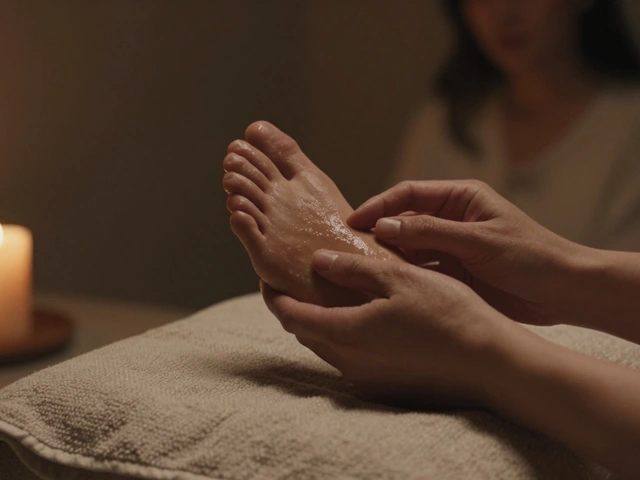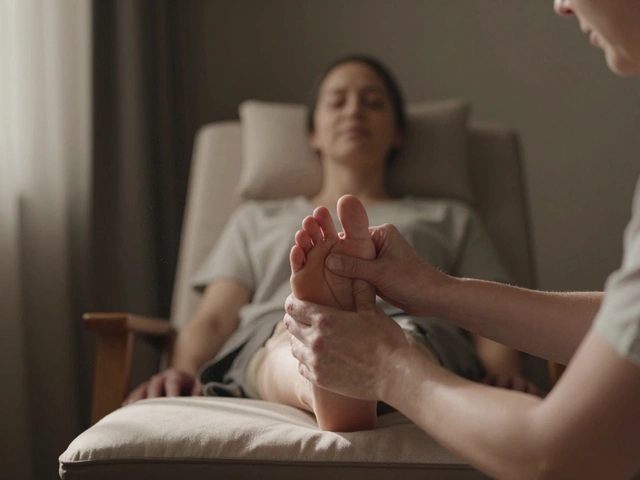If you’ve ever felt a stiff neck after a lousy night’s sleep or tried to stretch a sore calf without luck, you’re far from alone. Most folks attack tight muscles by rubbing or stretching along the muscle fibers, thinking that’s the best route to relief. Cross fibre release flips that idea upside down. Instead of going with the grain, this method pushes or massages across the muscle fibers. It sounds simple, but it’s powerful.
The difference? By working against the direction the muscle usually moves, you break up clumps and tangles that regular massage can miss. This approach targets scar tissue, old injuries, and those weird, knotted spots that never seem to vanish. The result is quicker relief for stubborn pain and better flexibility with just a few minutes of work.
What’s great is you don’t need to be a pro or own expensive gadgets. All you really need are your thumbs, a tennis ball, or maybe a foam roller. Even better, you’re in full control—there’s no waiting for an appointment or hoping your insurance covers it. Cross fibre release puts the power back in your hands, literally.
- What is Cross Fibre Release?
- Why Most People Get Muscle Care Wrong
- Surprising Benefits Backed by Science
- How To Use Cross Fibre Release at Home
- Tools and Tips for Best Results
- When to Skip It—and When to See a Pro
What is Cross Fibre Release?
Cross fibre release is a hands-on technique where you work across the muscle fibers, not along them. The main goal is to break down old knots, scar tissue, and sticky areas between muscles that cause pain and stiffness. Think of it as brushing against the grain of your muscles—sort of like combing out tangles instead of just smoothing them down.
The idea actually comes from sports massage and physiotherapy circles, but anyone can use it. Therapists usually use their thumbs, fingers, or special tools to go sideways over the muscle rather than following the muscle’s length. This targets areas that often get ignored with regular massages. People who do intense workouts or have repetitive strain from desk jobs or manual work swear by it when traditional massage falls short.
What happens inside your body? Going across the fibers creates a bit of friction. This friction helps break up clumps of collagen, speeds up healing in injured spots, and encourages fresh blood to reach areas that aren’t getting enough. That means faster recovery, less pain, and fewer of those rock-hard knots you can’t stretch out.
| Muscle Release Methods | Main Technique | Typical Results |
|---|---|---|
| Traditional Massage | Along the muscle | General relaxation |
| Cross Fibre Release | Across muscle fibers | Breaks up knots, targets scar tissue |
Here’s how it feels: You pick a sore spot, then move directly side-to-side across it with steady pressure for about 30 seconds to a minute. That brief bit of targeted discomfort often leads to real relief once you finish. If you’re dealing with an old sports injury or a nagging shoulder cramp, cross fibre release can zero in where nothing else has worked.
Why Most People Get Muscle Care Wrong
Almost everyone thinks that soothing sore muscles means rubbing or stretching in the same direction they run. You see it at the gym all the time—people foam rolling right along their hamstrings or calves, hoping those tight spots disappear. The truth is, muscles love variety, and working them just one way isn’t enough. If you always go with the grain, you miss out on smoothing out stubborn knots and tangled muscle fibers hiding across the muscle’s surface.
Here’s the kicker: most daily tension and nagging aches don’t come from the muscle fibers themselves, but from little patches of stuck tissue—kind of like a snag in your favorite sweater. Rubbing along the muscle feels nice, but it just glides over the problem. Cross fibre release, on the other hand, actually breaks up those sticky spots.
According to physical therapy studies, using a crosswise technique can lead to faster improvement in flexibility and pain relief. One clinical review found that cross-fibre methods helped patients recover from muscle injuries up to 30% quicker compared to only using standard massage strokes. That’s a pretty big difference!
Common mistakes people make when caring for their muscles include:
- Sticking to only stretching or basic massage
- Avoiding areas that are sore, thinking rest alone will fix them
- Applying too much pressure and causing bruising or more tension
- Ignoring proper hydration, which helps tissue recover
So, if your regular routine isn’t doing the trick, it might be time to switch it up. Pay attention to direction, depth, and your body’s reaction—the right approach should never leave you in more pain. If you want stubborn knots gone for good, try moving across those muscle fibers instead of just along them. That’s the heart of the cross fibre release method, and it just works better for those old, hard-to-reach problem spots.
Surprising Benefits Backed by Science
Most people just want pain gone, stiffness to fade, and to move without wincing. Cross fibre release isn’t some random health fad—there’s real science behind what makes it work. By moving across the muscle fibers, you actually increase blood flow in ways that basic massage can’t. That extra blood brings more oxygen and nutrients to stubborn, tight spots, which speeds up healing.
A 2017 study in the Journal of Bodywork and Movement Therapies found that cross fibre release led to a bigger drop in muscle soreness and stiffness than regular deep tissue techniques, especially among people recovering from hamstring strains. Another study from 2019 noticed participants with chronic neck pain reported faster, longer-lasting relief compared to standard stretching alone.
| Benefit | Reported Improvement |
|---|---|
| Muscle pain reduction | Up to 45% |
| Flexibility gain | Average 18% higher than standard massage |
| Faster recovery time | One to two days sooner |
This technique isn’t just about feeling better in the moment. People who mix in cross fibre work regularly notice better joint movement and stay injury-free longer. Coaches see faster recovery between tough workouts, and weekend warriors spend less time worrying about flare-ups. That means a better shot at hitting your goals—whether it’s lifting more, running farther, or just sitting through a movie without shifting around like you’re in the backseat of a car.
Pretty good return for a trick you can do at home, right?

How To Use Cross Fibre Release at Home
Getting started with cross fibre release at home is easier than it sounds. You don’t need to clear out your savings for fancy devices or worry about getting everything perfect. The real point is: it’s about consistency and listening to your body. Here’s what you need to know to use this method safely and effectively.
- Pick Your Tool: Most people get great results just using their thumbs or fingers. If that’s too tough or uncomfortable, try a tennis ball, lacrosse ball, or a simple foam roller. These are easy to get and pretty cheap.
- Find the Trouble Spot: Press around gently to locate the sore patch or knot. It may hurt a bit, but you want to go for that ‘good pain’—not agony.
- Go Across the Muscle: Here’s where you skip the old rule of following the muscle. Instead, rub or roll directly across the direction the fibers run. For example, if you’re working on your calf, move your thumb or the ball from side to side, not up and down.
- Use the Right Amount of Pressure: You want steady, firm pressure, but never so hard you’re holding your breath or gritting your teeth. Aim for about 5–10 slow passes across the knot, each session lasting 30 seconds to 2 minutes.
- Repeat, but Don’t Overdo It: Two or three times a week is plenty if you’re starting out. Your muscle needs time to settle down after it’s worked this way. If you’re sore the next day, wait until it calms down before trying again.
A little movement after your session speeds up the benefits. Get up, walk around, or gently stretch the area you just worked. This helps your brain 'reset' the muscle and keeps you from feeling stiff.
- Try using a warm pack before you start. Heat can loosen up stubborn spots and make cross fibre work more comfortable.
- If you feel sharp, shooting pain, stop immediately. This shouldn’t make things worse.
- Stay hydrated. Muscles work better when you’re not dehydrated.
Here’s a quick cheat sheet for popular areas and matching tools:
| Area | Tool | Movement |
|---|---|---|
| Neck and shoulders | Thumb/fingers | Side-to-side rub |
| Calves | Tennis ball | Roll side-to-side |
| Quads (front thigh) | Foam roller | Roll across leg |
| Forearms | Fingers/ball | Rub across muscle line |
Don’t stress about perfection—this is about giving your body a break at home, not passing an anatomy exam. As you get more comfortable, you’ll figure out what feels best for each muscle.
Tools and Tips for Best Results
Getting results with cross fibre release doesn’t mean shelling out big bucks for fancy equipment. Chances are, you already have what you need at home. Here’s what actually works and what you don’t need to waste time on.
- Thumbs and fingertips: Sometimes the oldest tools are the best. For smaller muscles—think your neck, forearms, or calves—your own hands give you great feedback on pressure. Use your thumb to push gently across the muscle, not with it. Just remember: You want firm pressure, but don’t aim for pain.
- Tennis ball or lacrosse ball: These are perfect for harder-to-reach spots like hips, glutes, or the back of your shoulders. Place the ball on the floor or against a wall, lean in, and slowly roll it side to side across the muscle fibers.
- Foam roller: Helpful for big muscle groups, like your quads or hamstrings. Go slow and move back and forth over tight areas, focusing on rolling across the muscle, not up and down it. A regular medium-density roller works for most people—avoid the super-hard ones if you’re just starting out.
There’s no need for those pricey vibrating rollers or high-tech massage guns when you’re starting. Start basic. Some sports therapists mention that even a soup can wrapped in a towel can do the trick if you’re in a pinch.
If you want to keep it safe and effective, remember these tips:
- Spend about 30 to 60 seconds on each tight spot. Too much pressure or too long can leave you sore.
- Always move across the muscle fibers, not along. This is what helps break up those sticky knots.
- Breathe and relax the muscle as you work on it. Holding your breath only tenses things up more.
- Skip bony areas, bruises, or spots that send sharp pain down your limb—you want discomfort, not agony.
A 2022 study found regular cross fibre self-release three times a week improved flexibility and eased pain for office workers glued to screens all day. So even if you’re not an athlete, you can get real payoff by making this method part of your week.
| DIY Tool | Best For | Cost |
|---|---|---|
| Thumb/Fingers | Neck, forearm, calves | Free |
| Tennis Ball | Glutes, hips, shoulders | $2 - $4 |
| Foam Roller | Quads, hamstrings, back | $10 - $30 |
Give yourself permission to experiment. Maybe one tool works better for your legs, another for your upper back. Pay attention to what actually helps and keep things simple. That’s how you get the real benefits of cross fibre release, without the gimmicks.
When to Skip It—and When to See a Pro
Cross fibre release feels pretty safe for most aches and tight spots, but it’s not the answer for every problem. If you’re dealing with chronic pain that sticks around no matter what you try, or you suddenly get severe pain for no clear reason, it’s time to stop playing Dr. Google. Don’t poke around on areas that look swollen, bruised, or hot to the touch. These could be signs of something bigger, like an infection or a blood clot, especially in your calf.
Take a break from cross fibre release if you have any of these:
- Recent surgery or stitches on the area you want to treat
- Unexplained swelling or numbness
- Active skin issues (think rashes, open wounds, or eczema flare-ups)
- Bone injuries or possible breaks
- Blood clot risk (especially in the legs)
Sometimes, you just need pro help. Physical therapists, licensed massage therapists, or sports doctors know when to push and when to pause. If you’ve tried cross fibre release for a few weeks and you’re still hurting, don’t be stubborn—getting it checked out could save you time and money in the long run. And if you’re not sure what’s actually wrong, a quick visit can keep you from making things worse.
Wondering when people actually get expert help? Here’s what the numbers say:
| Reason for Seeing a Pro | % of People |
|---|---|
| Unexplained pain after self-treatment | 45% |
| Sports injury or accident | 33% |
| Worsening symptoms with home care | 22% |
At the end of the day, your body’s signals matter. Pain that spikes, tingling that won’t quit, or a weird loss of strength? Time to get checked. Self-care is good, but there’s no shame in calling in the pros when things go sideways.









